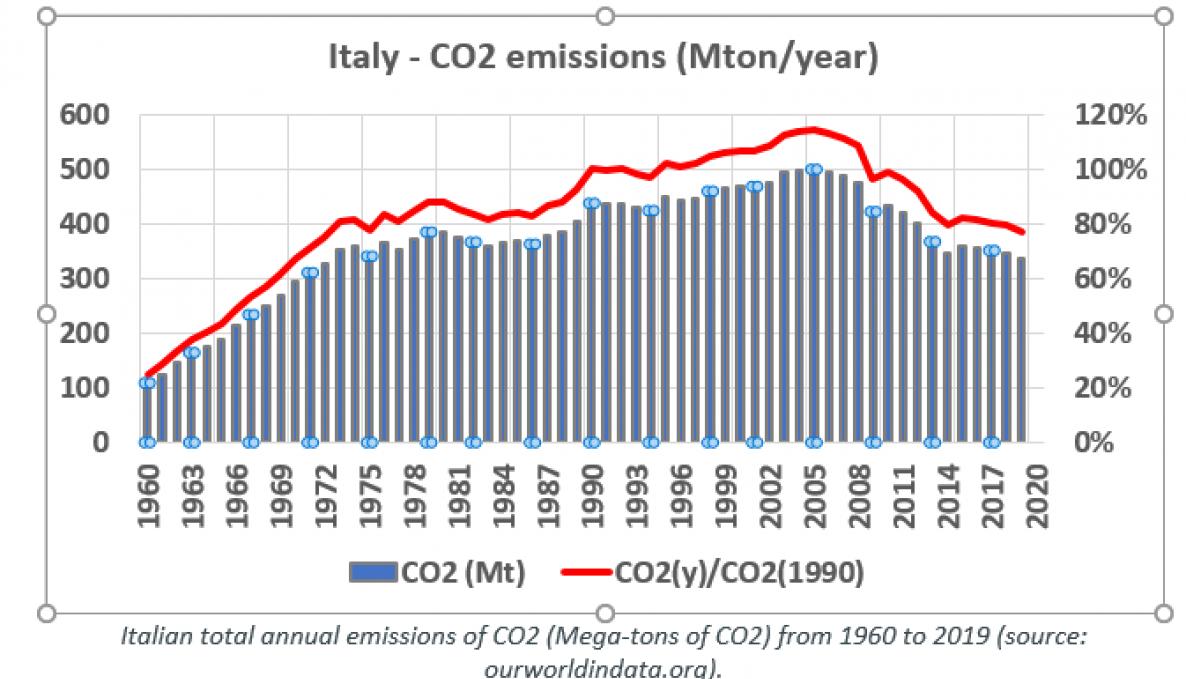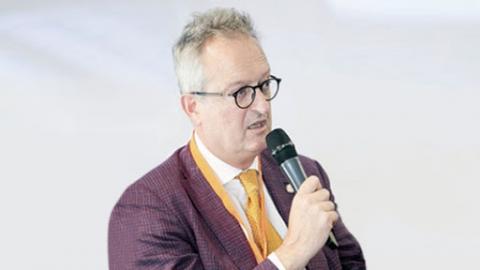19 March 2021, speech by Roberto Buizza, full professor of physics at the Intitute of Life Sciences at the Sant’Anna School: “Actions that can bring us to zero net emissions”

On Friday 19 March 2021, a new “Climate Strike” is held. In this speech, Roberto Buizza, full professor of physics at the Institute of Life Sciences of the Sant'Anna School, presents some actions that that can bring us to zero-net-emissions.
by Roberto Buizza
In this climate strike day, I think it could be interesting to look at the Italian emissions of CO2, and then list a set of actions that can help the country to reach zero-net-emissions by 2050, or earlier.
The figure below shows that in 2019 the Italian annual total CO2 emissions were 337 Mega-tons (106 tons), about 23% less than the 1990 level. Emissions climbed from about 109 Mtons in 1960, to the peak value of about 500 Mtons in 2005, to then start climbing down to about 337 Mtons in 2019 (values in 2020 are expected to be ~5-7% less than in 2019 due to COVID).
The Paris Agreement signed by 195 countries (including Italy) at the 21st Conference of the Parties (COP21) in 2015 aimed to substantially reduce global greenhouse gas emissions and to limit the global temperature increase in this century to 2 degrees Celsius while pursuing means to limit the increase even further to 1.5 degrees (see e.g. https://www.un.org/en/climatechange/paris-agreement).
To achieve this target, emissions has to be reduced to zero as quickly as possible.
The European Commission, as part of the European Green Deal (see e.g. https://ec.europa.eu/clima/policies/strategies/2030_en ), proposed in September 2020 to raise the 2030 greenhouse gas emission reduction target, including emissions and removals, to at least 55% compared to 1990. For Italy, this would mean to reduce emissions to about 250 Mtons, the level of 1968. This reduction has then to continue to reach ZERO by 2050, if we want to keep the global average warming in this century to about 2 degrees, as agreed at COP21.
Here is a list of actions that can help any country to reach zero-net-emissions. Actions that has to be implemented now, without any delay:
9) Electricity: sustain the growth rate of renewables and other zero and low carbon power to reach 100% by 2050.
10) Transport:
a. Last fossil fuel car sold before 2035;
b. 100% electric public transport by 2030;
c. Aviation and shipping: develop and get agreement on a ‘zero-net-emission’ compatible vision.
11) Buildings: all new buildings fossil-free and near zero energy by 2025, and increase building renovation rates (to fossil-free) of at least 5% per year.
12) Industry: all new installations in emissions-intensive sectors must be low-carbon; maximise material efficiency.
13) Agriculture and land use: reduce emissions from forestry and other land use to 95% below 2010 levels by 2030, and stop net deforestation by the 2025; for commercial agriculture, reduce emissions (optimize water usage, reduce transport and packaging), establish and disseminate best practice.
14) CO2 removal: promote research and planning for negative emissions.
15) Countries should:
a. By law, set “zero-net-emissions” as the goal for 2050, and establish that the total country green-house-gas emissions have to be reduced by at least 7.5% every year from 2021 till zero-net-emissions are achieved;
b. Plan ahead the right mix of policies that can offer immediate benefits to whoever takes actions, and penalties to whoever continues to emit;
c. Establish a realistic and effective carbon tax that will reduce the green price premium of products and services, and use the tax incomes to subsidize de-carbonization; use carbon pricing to pass the right signals to the market;
d. Go beyond prices with a policy package that triggers a de-carbonisation of all human activities (industry 5.0 = industry 4.0 minus CO2) and behaviours;
e. Smooth the transition for those who stand to be most affected, to ensure that decarbonization contributes to economic development and the sustainable eradication of poverty;
f. Remove fossil fuel subsidies;
g. Tackle regulatory and market rigidities that favour fossil fuel incumbency in the electricity sector, and which undermine demand-side options that could empower consumers to choose clean energy.
16) Cities should:
h. Optimize energy use across all sectors;
i. Decarbonize: incentivize a transition to clean, zero-carbon energy sources for producing electricity;
j. Electrify: switch from fossil fuels to electricity for all transportation and buildings.
Come didascalia alla tabella sulle emissioni di CO2
Italian total annual emissions of CO2 (Mega-tons of CO2) from 1960 to 2019 (source: ourworldindata.org)




